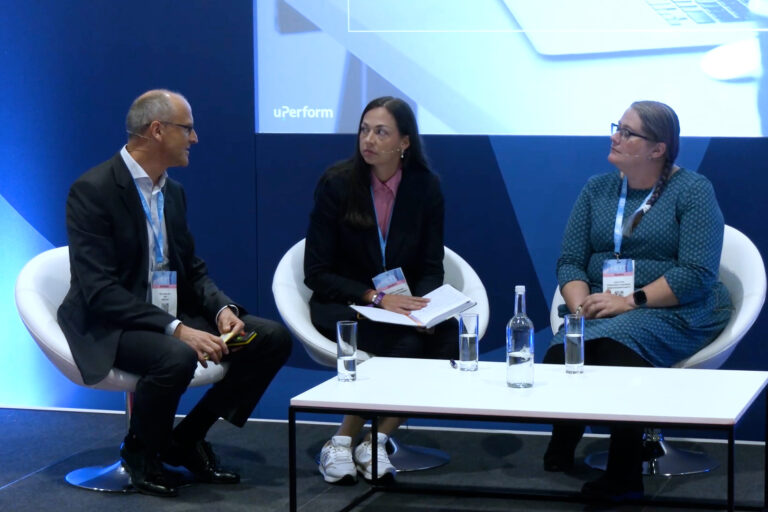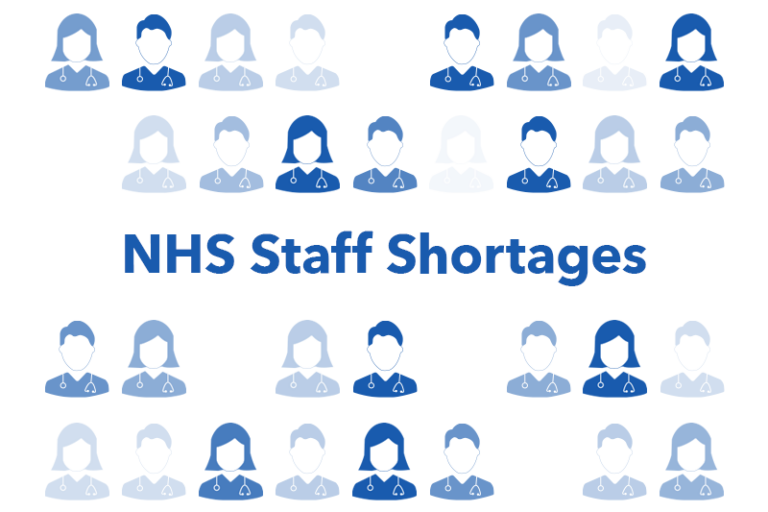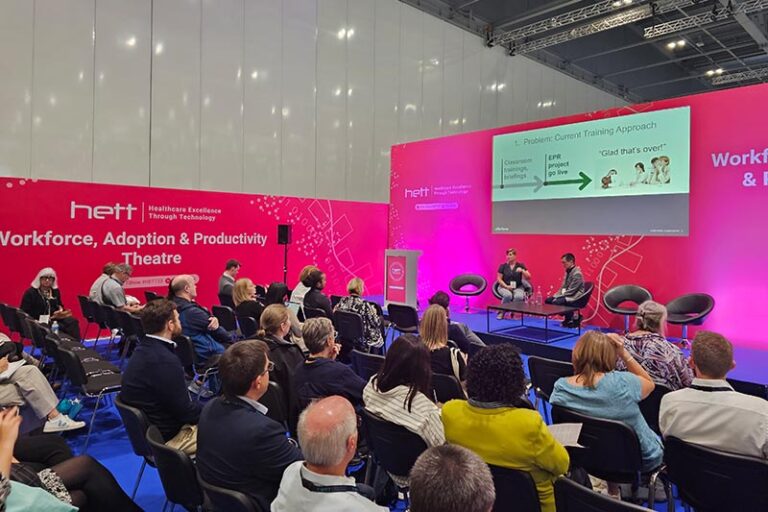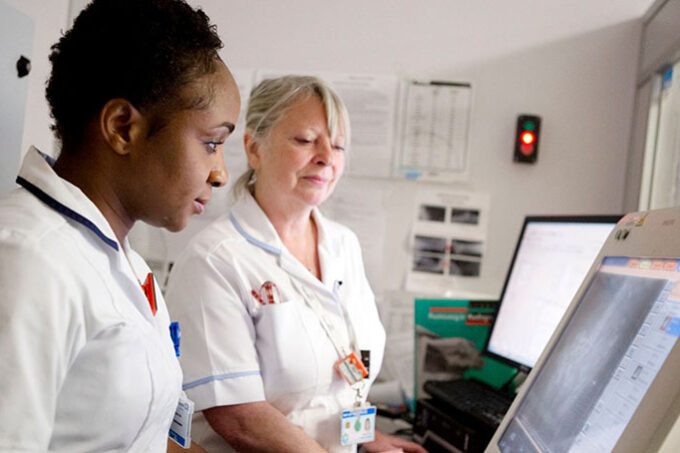This article is available courtesy of Health Tech News. You can view the original article on their website here.
Our latest panel discussion focused on strategies for empowering a digital workforce, and how to develop workforce technology literacy through scalable and effective digital learning and support programmes.
From Cambridge University Hospitals (CUH) we were joined by Dr Wai Keong Wong, director of digital and consultant haematologist, and Claire Tolliday, chief nursing information officer, along with uPerform’s EHR education director Liz Griffith. Our panellists shared their experience and advice in this area, including how to overcome challenges such as scaling on-demand training and performance support to keep up with rollouts and upgrades; reducing frustration by delivering training materials when and where they are needed; and saving time for caregivers to focus on their patients.
The panel got started with some insights into our panellists’ work and backgrounds. Liz kicked things off by highlighting how uPerform has been working with CUH along with a number of other healthcare organisations on their digital transformation journey. Wai Keong explained that he oversees all aspects of digital at CUH, from infrastructure to the EPR, and Claire added that she has been involved with the trust’s EPR rollout since 2013.
CUH’s digital journey
HTN posed a question to the panellists: when thinking about CUH’s journey and achievements thus far, do they feel that they have reached full digital transformation?
Reflecting on the fact that the trust is now 10 years into its EPR, Claire said: “I don’t think you can ever say that you are completely digitally transformed. Technology is changing constantly, so you have to continue to move with that and make sure that you keep transforming as you go.”
Wai Keong commented: “I suppose the question really is, ‘When do you know that you are digitally transformed’. It’s a difficult question to answer. You don’t wake up one day and feel like you’ve achieved it. I think the moment you know that you are digitally transformed is when you feel that the care you are receiving as patient feels palpably different from how it felt 10 or 20 years ago. It’s when you can feel the step change in how you interact with the organisation, with the clinicians.
“I do think we are a very highly digitised organisation – all aspects of care are covered in some form by digital and there is very little paper to be seen. We are digitally optimised and things feel efficient and safe. Does it feel like a digitally transformed organisation? I would say that we have a good foundation to build towards that goal. We haven’t yet experienced that big step change, but we are on that journey.”
On uPerform’s aims and how they have supported CUH, Liz said: “The work that we do is designed to support any health system in delivering training for their EPR, which is obviously one of the largest pieces of any digital journey. When it comes to digital transformation, it’s always about the people; any time that we are trying to adapt digital tools, we have to ask ourselves how it works out for the users and how they will adapt to ongoing change. When you have upgrades, when you have new pieces of your digital tools rolling out, how can you make sure that users will adopt them, that they will build them into their workflows and patient care? That comes with training, and training can be a really sticky situation between knowing that you need it but feeling that you don’t have time to do it. Then it’s back to the system to look into removing those roadblocks and ensure that staff have direct access to any training that they need. That’s where we come in.”
Developing workforce technology literacy
Claire noted that CUH is regarded as a “very digitally mature organisation” and acknowledged that whilst that might attract some people, it also has the potential to put others off.
“I’ve done some work with our workforce team, looking at how we can ensure that people are still encouraged to come and work here even though we are digitally mature – emphasising that they will be given the skills to use the technology that we have in place. We have a huge variety of staff; some have been very keen to use the technology, some less so, partly because they were worried that they might break the technology somehow. It’s about giving people the skills and the confidence to use it and know that they are still providing very good care.”
On whether she has seen much change in this area over the past 10 years, Claire continued: “There has been a shift – certainly some of the younger staff that are coming through have used technology throughout formative years and throughout schooling, so coming into a digitally mature organisation tends to be less intimidating for them. They tend to pick it up quicker than when we first started.
“We do find that if we are employing staff who are coming from less mature NHS trusts that there is some anxiety in this area, but we offer a really robust training programme, including support on things like how to switch on the tech in the first place and operate it on a basic level as well as the more complex side.”

Successful approaches: enhancing digital skills
For digital transformation, Wai Keong considered, you need good enabling technology; people to know how to engage with that technology; and you will likely need to introduce new processes such as mandatory training and refresher training, to get the best out of the digital investment and to realise the full benefit.
In Cambridge, he said, there is good understanding around the importance of having training embedded right from the beginning. “It’s not a separate department, and the training team themselves attend the same training as the people who configure the system. That means they aren’t just delivering training in the manner in which they have been taught; they actually do understand how the system works. The integration of training teams in this way is a key enabler to ensuring that things are always up-to-date and fit-for-purpose.”
Building on this point, Wai Keong shared his view that the “next level” for Cambridge would see staff not just using technology, but understanding how the technology works so that “you can use it as a way of reimagining how you work”. He added that CUH has “very driven and very innovative thinking from clinicians and operational managers, with a strong drive to make the service better. That’s very important. But do they have enough knowledge about the systems themselves? That’s something that I don’t think had been formally addressed yet. We do have pockets of excellence, but the question is how you can scale those up for such a large, complex organisation.”
The decision to work with uPerform is part of CUH’s efforts to enhance both elements of this, he said; furthering the use of technology, and developing understanding of it.
Liz shared insight into her experiences around enhancing digital skills, pointing out that “one of the best things about e-learning is simply scalability. You can deliver training across 13,000 users when they need it. It’s really difficult for an individual to get the help that they need if they have to go and physically find a specific person for it, or if they have to wait to sign up for a class at a later date. With a small training team, you can only handle so many classes and when you are constantly handling an influx of new staff, they are the number one priority. That’s true across any health system.

Liz explained that prior to working with uPerform she worked with KLAS Research on the Arch Collaborative (a group of healthcare organisations working to improve electronic health records experience through surveys and benchmarking). On whether users tend to prefer e-learning or classroom learning, she acknowledged that people often say they prefer the in-person option. “I think that’s our human nature,” she reflected. “We’re always going to say that we prefer what is comfortable and feels familiar, the option we have grown up with. I myself grew up without a lot of online training and I can see that sometimes it can feel a little uncomfortable.a However, I really value my ability to access information and resources online, and I think a lot of us are getting better at doing this in our personal life – YouTube videos or tutorials on something we are interested in, for example.”
She highlighted that KLAS also explores metrics such as how much time people believe they save, based on training type. “Clinicians are saying, on average, that they are saving over 91 minutes per week if they spend an hour in online training,” she reported. “In comparison, they say they save 31 minutes per week if they spend an hour in a classroom. So when you start talking about scaling training organisation across a large organisation, delivering just-in-time training within your digital tools like your EPR is a clear way to win time back for patient care.”
Preparing users for upcoming changes

Additionally, he said, communications, engagement and training teams need to be part of any go-live or significant change to a digital process or tool; they need to be present in every senior team meeting so their input is designed into the process from the beginning.
Claire agreed: “One of the most important factors is communication. You need to engage your end users as you are making changes to your system.”
Claire chairs a clinical informatics group and explained that often, when she knows that there is an upgrade or new functionality coming in, the changes will be taken to that group so that they can provide feedback or advice. “We don’t want people to feel that IT is being done to them,” she stated. “Everybody impacted needs to be included in the decisions.”
Liz agreed and added: “If we could get every health system to say that they don’t want users to feel like IT is being done to them, I think we would all be in a better place. It’s always going to be about the people; they have to come first. That’s really the key message here; the shared experience of clinical and IT, and the need to create that culture.”
“Digital transformation of an organisation is not an IT project,” confirmed Wai Keong. “It is a whole organisation change management project that needs to be prioritised above a lot of other things. It shouldn’t just be discussed among the digital team; it needs to be what the board is talking about and monitoring very closely.”
Identifying digital literacy needs
On supporting people with low levels of digital literacy, both around a go-live and on an ongoing basis, Claire said: “Everybody sent through the same level of training for our EPR. It was intense; we started nine months before we went live, we were offering training at weekends, we had additional facilities built so that we could get all of the staff who would be using the EPR through our training programme.”
During these sessions, she continued, the team were able to pick up on people who might be struggling and in need of extra support – whether that was because they were actively asking a lot of questions, or because they were not asking questions at all. “We have very skilled trainers, they’ve gone through a robust training programme themselves, so they know what they are looking for.”
Liz noted that a question often arising in the US is whether it should be possible to “test out of training, or bypass certain levels”. She highlighted an example from a client in Colorado where the organisation made a blanket decision that this was not allowed, explaining that often staff came from organisations using the same digital tools and as such did not believe they required training. “They found that when they allowed people to test out of training, they would miss out on very important workflow changes that differ between organisations,” Liz explained. “That’s an important aspect of digital literacy to consider. I know how to use a computer, for example, but I may not know how to use all of the workflows or the IT policies at a new organisation.”
She also raised the point that it is the workflows that matter most, pointing out that research from KLAS indicated that the “best” training was considered by users to be training with workflow information specific to them and their role.
“The question is: how does this education tool help me become a better clinician,” Wai Keong said. “This is where the alignment between digital and the rest of the hospital can really come together.”
The “tip sheets” designed to provide information at CUH are “very workflow-driven,” Claire said, “but there is often the question of why they need to use this tool or use it in this way. Being able to align trust policy and procedures with your tip sheets and the actual workflows that you are using is really beneficial.”
What is the next big opportunity or challenge with workforce technology literacy?
Liz explained that uPerform’s product helps to deliver training directly within a workflow, an offer which comes in various forms; tip sheets, simulations, and videos. “I think video is the next frontier when it comes to adult education,” she said. “Social media, for example, has made it very popular to see 30 second videos containing quick tips on how to do something or improve something. We have several clients talking about ‘viral learning moments’, whereby they are trying to create these viral learning moments within their organisations. They are enlisting clinicians who are already supporting their colleagues as digital champions and looking to leverage their knowledge, and also to try and make learning fun. It’s about finding a way to tap into the part of our brain that makes us interested enough to watch a short YouTube video to discover something new, and applying that to IT learning.”
Coming back to Claire and Wai Keong’s points about seeing a more digitally mature workforce start to come in at the point of entry, Liz considered that the next challenge in this space is “the very high expectations of what digital should be able to do for them. Managing expectations around ease of usability is a new challenge.”
From Wai Keong’s perspective, an interesting development in this space lies in artificial intelligence. “I don’t mind using the EPR, but I would prefer if I could take back some time to spend with my patients and have someone or something else handle the EPR for me,” he said. “This is where the massive progress made around AI in the last few years can come into play. It has the benefit of almost humanising the EPR; that then allows me to concentrate on delivering care so the patient has my undivided attention, whilst the computer handles the administrative work for me. In the coming years, I hope that human and computer interaction can be significantly enhanced to support this.”
Claire commented that when it comes to change requests from users about the system, those requests have become better developed over time as people have an improved understanding of EPRs. People also bring in ideas from other places with an EPR. “We are always looking at changes and opportunities,” she reflected. “The challenge is resource within the teams.”
Bringing in developments as a result of the collaboration with uPerform will be “game-changing”, Claire suggested. “Being in a workflow and being able to click a button and see the instructions for that specific workflow – that’s going to make such a difference for learning, training and confidence, as well as their competency.”
Advice for other trusts on digital transformation journeys
Wai Keong said: “The main piece of advice I’d give is not to see it as a digital project. Don’t underestimate the impact on the whole organisation of moving from a highly paper-based process to a digital one, it is immense. Most if not all organisations have a lot of hidden workarounds that are going on all the time, and all these workarounds have evolved over time – a hidden glue keeping everything together. When you undertake a digital transformation project and understanding all your processes, you start to understand how much you don’t understand about your processes. You need to recognise this and take everything into account, because you’ll be shaking that glue apart.”
Claire said that it comes back to communication and involvement. “Involve your staff from the very beginning. Talk to them about it. Go through individual workflows. You need to spend time with groups of clinicians asking about how things work and sharing your plans so you’re getting collaborative communication at all levels.”
Finally, Liz offered: “It’s never a neat project. There’s no moment where you get to walk away and think you’re done with it. You keep that in mind, and remember that it is a people project above all else.”
Many thanks to Liz, Claire and Wai Keong for joining us.
Learn more about uPerform
Want to learn more about how uPerform is partnering with health systems to help them scale training, drive satisfaction and support user proficiency? Check out our healthcare page or read more about our partnership with Cambridge University Hospitals.






